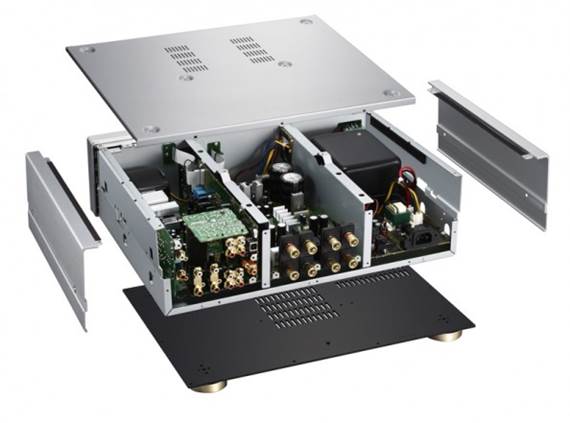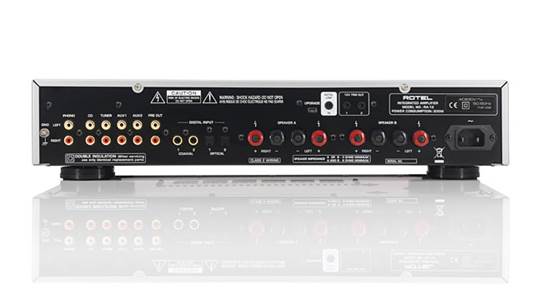Pioneer A-70
Class-D amplification
Contrary to popular belief, the ‘D’ doesn’t
stand for ‘digital’. This type of amp circuit runs cooler and more efficiently
than class-A or -B amps, and is becoming far more prevalent in hi-fi kit due to
its eco-cred.
The Pioneer A-70 is the company’s high-end
stereo amp – a Class D model and sits atop of the new range of five with a
fittingly impressive feature set.
Before you’ve even turned it on, the A-70
makes a memorable impression. It’s considerably bigger than the other amps
here, not to mention much heavier, weighing in at a touch over 17kg.

Pioneer
A-70
While you might need a hand to lug it out
of the box, it’s a small price to pay for such a solid, quality finish; the
whole chassis is made from aluminum panels.
The front of the A-70 looks equally
well-made, if rather busy, with dials and buttons that match an equally busy
remote. The five dials control input selection, volume, bass, treble and
balance, and there are buttons for selecting between speaker setups, a
‘loudness’ button for added punch to low-volume playback and a ‘direct’ button
for bypassing the tonal controls.
There’s even a button for switching the
phonon stage between the moving magnet and moving coil inputs, unusual at this
grade and a USP for the A-70 in this test, adding another string to its already
well-equipped bow.
It does only have three line level inputs,
which is a little on the light side, but goes someway to making up for that
with a built-in DAC, complete with coaxial and USB inputs that will accept
high-res files up to 24-bit/192kHz. RCA sockets allow the A-70 to be used as a
power amp for your home cinema, too.

There’s
even a button for switching the phonon stage between the moving magnet and
moving coil inputs, unusual at this grade and a USP for the A-70 in this test,
adding another string to its already well-equipped bow
With an impressive 90W per channel,
the A-70 serves up a powerful sound. The bass has a kick that leaves some
rivals sounding positively thin. It’s an exceptionally open sound too
Power and detail in abundance
Turn on the A-70 and its size translates
into a similarly powerful performance, with an impressive stated 90W per
channel. The bass is taut and suitably punchy, with a real kick that leaves
amps such as the Onix and Rotel RA-12 sounding positively thin in comparison.
It’s an exceptionally open sound too, and a
play through of Vivaldi’s Four Seasons (Winter) shows off the pure level of
detail the A-70 is capable of offering. Press the ‘direct’ button and it goes
up a notch, tightening up the sound and widening the soundstage even more.

There’s
no shortage of power here, but complexity makes things unravel a little
However, this piece of music also shows up
the A-70’s weaknesses. While the solo violin is relayed with admirable clarity,
once things get more complex, the A-70 seems to lose its way.
It lacks a sense of momentum and rhythm
which means it can sound rather messy, throwing everything slightly off tempo
and skipping over more subtle elements of the track. Unfortunately, we found
this to be a trait that reappeared across the amp’s digital inputs too.
Overall, the A-70 is certainly a well
put-together bit of kit with a generous spec list, albeit towards the top end
of our price range. If you’re looking for a clear and powerful sound, you’ll
find it in abundance here – but it’s the A-70’s rhythmic shortcomings that
cause it to fall just short of greatness.
Class-D amplification
Contrary to popular belief, the ‘D’ doesn’t
stand for ‘digital’. This type of amp circuit runs cooler and more efficiently
than class-A or –B amps, and is becoming far more prevalent in hi-fi kit due to
its eco-cred
Rating: 4/5
For: Strong build quality; lots of
features; powerful sound; great clarity
Against: Lacks a sense of momentum and
subtlety when music gets busy
Verdict: A well-featured, powerful amp, but
not the last word in timing or dynamic finesse
Pioneer A-70 specs
·
Type: Integrated
·
Power: 90W
·
Tuner: No
·
Inputs: Line level x 3
·
Outputs: Preamp, speakers, headphones
·
Phonon stage: Moving magnet, moving coil
·
Tape Loops: 1
·
Tone Controls: Yes
·
Remote Control: Yes
·
Finishes: 2
·
Dimensions (H x W x D): 14 x 43.5 x 36cm
Rotel RA-12
Price: $1,373
With its Award-winning sibling the RA-10
sitting pretty beneath it, the Rotel RA-12 was always under pressure.
On paper, the differences between the two
are clear. The RA-12 has an increased 60W per channel (up from the RA-10’s
40W), a built-in DAC worth $269 if bought separately and the possibility of
Bluetooth connectivity. It’s bigger too, and nicely built with an added display
and more buttons in place of the RA-10’s perhaps nicer-looking dials.

Rotel
RA-12
On the back you’ll find five line-level
inputs (including moving-magnet phonon), four digital inputs (two optical and
two coaxial sockets), two sets of speaker outputs and preamp outs.
As with the Pioneer A-70 (previous), Rotel
has provided a built-in DAC (it can handle files up to 16-bit-48kHz) – and at
this price, its inclusion is to the company’s credit.
It also goes some way to make up for the
lack of FLAC or Apple Lossless support via the front USB port (it only accepts
WMAs up to 16-bit/48kHZ, as well as AAC, MP3 and WAV, although you can plug in
a Bluetooth dongle too…)
Before we start getting into the
nitty-gritty of what RA-12 sounds like, it’s worth remembering that it’s the cheaper
amp here, and one of the best featured too – even compared with the pricier
amps.
Following the act of its
Award-winning little brother, the RA-10, was always going to be tough and while
the RA-12 puts in a commendable performance, it falls just short of those
heights
A stable performance
Belting out Lady Gaga’s Paparazzi, the
RA-12 shows it shares a similar tonal balance to its sibling, offering an even
presentation from top to bottom.
The midrange is particularly articulate but
the bass could pack a little more punch for our tastes. Without it, we found
the amp was in danger of sounding a little restrained when it came to playing
livelier tracks.
We also found the RA-12 moved less subtly
between the quiet and loud sections of music compared with pricier amps such as
the Naim Nait 5i.

Packed
with features – including optional Bluetooth – the RA-12 is well worth a listen
However, while it might fall behind in
dynamic thrust, there’s a decent amount of detail here, especially when you consider that
it’s nearly $538 cheaper than Naim’s offering in this test.
It’s also got some real power behind it,
and stays composed even at higher volumes, offering a strong and stable
performance throughout.
Switch to the digital inputs and we found
the sound to be largely consistent, if slightly brighter, adding some welcome
sparkle to the top end.
Overall, the Rotel RA-12 is a good,
competent amp. It does just enough to keep you listening, but lacks that little
something extra to take it from being simply good to something really special.
But while it doesn’t offer the best sound
in our test, its feature list falls massively in its favor, and will no doubt
prove appealing for those looking for a solid, well-featured stereo amp.

Overall,
the Rotel RA-12 is a good, competent amp
Wireless is more
Rotel’s inclusion of a USB socket and
provision for its own Bluetooth dongle (which comes with the amplifier) opens
up the RA-12 for use with smartphones and tablets – a remarkably forward
thinking step.
Rating: 4/5
For: Well-balanced sound; good control;
decent detail; well featured
Against: Lacks subtlety and panache
Verdict: A well-priced, well-balanced and
well-featured amp that just falls short when it comes to expression
Rotel RA-12 specs
·
Type: Integrated
·
Power: 60W
·
Tuner: No
·
Inputs: Line level x 4, USB
·
Outputs: Preamp, speakers, headphones
·
Phonon stage: Moving magnet
·
Tape Loops: 1
·
Tone Controls: Yes
·
Remote Control: Yes
·
Finishes: 2
·
Dimensions (H x W x D): 14 x 43.5 x 36cm